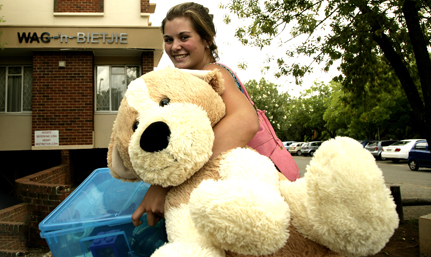|
 |
|
Photo: Johan Roux
21 January 2013 |
Beginning 2013, the Bloemfontein Campus is seeing the opening of two new residences where male and female students will be housed under one roof but in separate units. Each residence will house 250 students.
House ConLaurês and House Outeniqua were opened for their first-years and Residence Committee (RC) on Friday 18 January 2013. The two newly Residence Heads, Mr Frank Makhabane (ConLaurês) and Mrs Leani Wimble (Outeniqua) welcomed the new residents.
The uniqueness of these residences is that they will be the first co-ed residences on campus. These residences are wheel chair friendly with fully equipped disabled rooms available. All signage has also been done in Braille. Each floor of the new residences has two lounges, as well as a fully fitted kitchen.
The Prime of House ConLaurês, Sherilyn Roelofse, says, “We aim to create a living space that is holistic and welcoming and will allow our residence members to be able to excel in a number of things”. Sherilyn says ConLaurês comes from the word “Condo Laurus”, which means dreams of victory. The House’s slogan is “The Symphony of Dreams”. Students came up with the name for the residence.
Tsatsi Mokoena, RC member responsible for RAG at House ConLaurês says RC members have been working hard for the past few months, trying to imagine how to do things without a physical structure. ConLaurês will be a residence with an inspirational living space where each student feels welcome, respected for who they are and at home, so that they will have the confidence to follow their dreams.”
The Prime of Outeniqua, Vusumzi Mesatywa says, “Change is always welcome and that is the mindset that we will be embracing as the new residences. When a student graduates, we need them to graduate not only as academics, but also as humans, holistic beings”.
Marla Stanier, RC First-Year Mentor at Outeniqua, says that new experiences await every student that walks through the doors of the residence. “As excited as we are, this new experience will test us in many ways.However, if we stand together as one, we will succeed.”
Mr Quintin Koetaan, Director of Housing and Residence Affairs, says, “The opening of ConLaurês and Outeniqua is a dream come true, providing accommodation for a new generation of students in the 21st Century”.